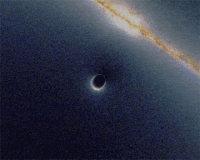
Back Singulariteit (sterrekunde) Afrikaans Singularität (Astronomie) ALS تفرد جذبوي Arabic Singularidá gravitacional AST Гравітацыйная сінгулярнасць Byelorussian Гравитационна сингулярност Bulgarian মহাকর্ষীয় অদ্বৈত অবস্থান Bengali/Bangla Esparder gravitadur Breton Singularitat gravitatòria Catalan Gravitační singularita Czech

| General relativity |
|---|
 |
A gravitational singularity, spacetime singularity or simply singularity is a condition in which gravity is predicted to be so intense that spacetime itself would break down catastrophically. As such, a singularity is by definition no longer part of the regular spacetime and cannot be determined by "where" or "when". Gravitational singularities exist at a junction between general relativity and quantum mechanics; therefore, the properties of the singularity cannot be described without an established theory of quantum gravity. Trying to find a complete and precise definition of singularities in the theory of general relativity, the current best theory of gravity, remains a difficult problem.[1][2] A singularity in general relativity can be defined by the scalar invariant curvature becoming infinite[3] or, better, by a geodesic being incomplete.[4]
Gravitational singularities are mainly considered in the context of general relativity, where density would become infinite at the center of a black hole without corrections from quantum mechanics, and within astrophysics and cosmology as the earliest state of the universe during the Big Bang. Physicists have not reached a consensus about what actually happens at the extreme densities predicted by singularities (including at the start of the Big Bang).[5]
General relativity predicts that any object collapsing beyond a certain point (for stars this is the Schwarzschild radius) would form a black hole, inside which a singularity (covered by an event horizon) would be formed.[2] The Penrose–Hawking singularity theorems define a singularity to have geodesics that cannot be extended in a smooth manner.[6] The termination of such a geodesic is considered to be the singularity.
Modern theory asserts that the initial state of the universe, at the beginning of the Big Bang, was a singularity.[7] In this case, the universe did not collapse into a black hole, because currently-known calculations and density limits for gravitational collapse are usually based upon objects of relatively constant size, such as stars, and do not necessarily apply in the same way to rapidly expanding space such as the Big Bang. Neither general relativity nor quantum mechanics can currently describe the earliest moments of the Big Bang,[8] but in general, quantum mechanics does not permit particles to inhabit a space smaller than their wavelengths.[9]
- ^ See section 2.2 What is a singularity? p.28-31 in Earman, John (1995). Bangs, crunches, whimpers, and shrieks: Singularities and acausalities in relativistic spacetimes. Oxford University Press. ISBN 019509591X.
- ^ a b Curiel, Erik (2021). "Singularities and Black Holes". Stanford Encyclopedia of Philosophy. Metaphysics Research Lab, Stanford University. Retrieved 1 October 2021.
- ^ "Singularities". Physics of the Universe.
- ^ Claes Uggla (2006). "Spacetime Singularities". Einstein Online. 2 (1002). Max Planck Institute for Gravitational Physics. Archived from the original on 2017-01-24. Retrieved 2015-10-20.
- ^ See Chapter 8 "Afterword" in Earman, John (1995). Bangs, crunches, whimpers, and shrieks: Singularities and acausalities in relativistic spacetimes. Oxford University Press. ISBN 019509591X.
- ^ Moulay, Emmanuel. "The universe and photons" (PDF). FQXi Foundational Questions Institute. Retrieved 26 December 2012.
- ^ Wald, p. 99
- ^ Hawking, Stephen. "The Beginning of Time". Stephen Hawking: The Official Website. Cambridge University. Archived from the original on 6 October 2014. Retrieved 26 December 2012.
- ^ Zebrowski, Ernest (2000). A History of the Circle: Mathematical Reasoning and the Physical Universe. Piscataway NJ: Rutgers University Press. p. 180. ISBN 978-0813528984.
© MMXXIII Rich X Search. We shall prevail. All rights reserved. Rich X Search
